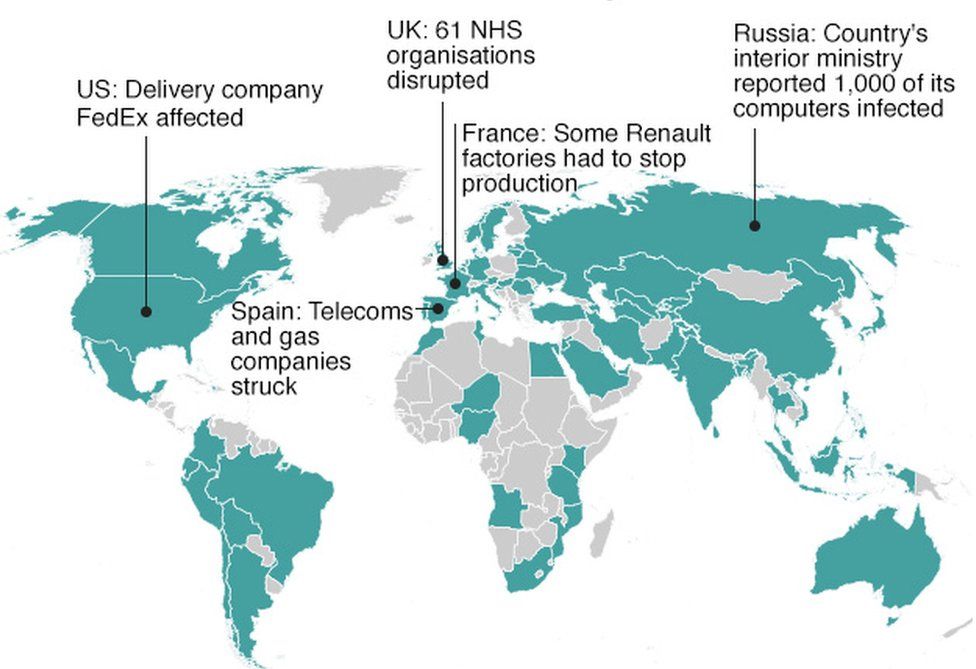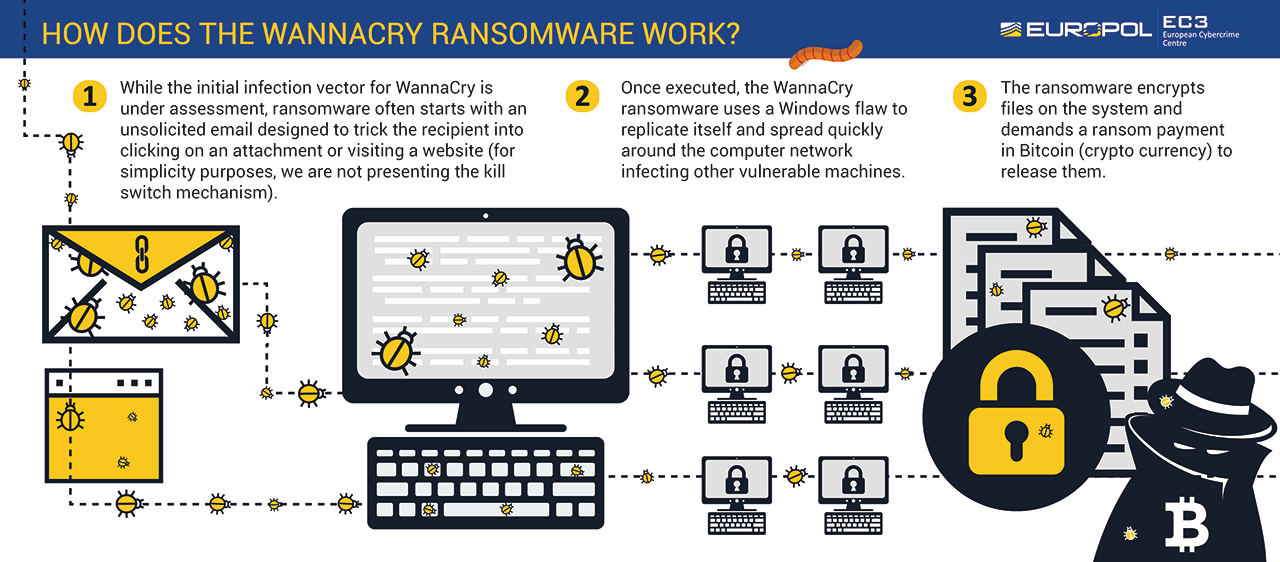
Overview of the Wannacry Cyberattack
The Wannacry cyberattack occurred in May 2017 and targeted computers running the Microsoft Windows operating system. The attack utilized ransomware, a type of malware that encrypts files and demands payment in Bitcoin to restore access. Wannacry spread fast using a worm that took advantage of a vulnerability in Windows systems known as EternalBlue, which had been leaked by a group called the Shadow Brokers.
The attack affected many computers in 150 countries, including hospitals, government agencies, and businesses. The malware demanded a ransom in exchange for the decryption key, causing panic and disruption worldwide. While some victims paid the ransom, others sought alternative solutions or relied on backups to restore their systems.
Understanding the Global Impact of Wannacry
The Wannacry cyber attack had far-reaching consequences that extended beyond the immediate financial losses incurred by affected organizations. It exposed critical vulnerabilities in outdated or poorly maintained systems, shedding light on the urgent need for robust cybersecurity practices.
The attack showed how our digital systems are connected and how cyber threats can disrupt important services and operations. Hospitals were forced to cancel surgeries, government agencies struggled to function, and businesses faced significant financial losses. The widespread impact of Wannacry served as a wake-up call for individuals and organizations to prioritize cybersecurity and invest in preventative measures.
In response to the attack, governments and cybersecurity agencies around the world intensified efforts to strengthen defenses against similar threats. The incident made people more aware of cybersecurity risks and the need to update software regularly.
The Wannacry cyberattack was expensive and caused a lot of problems. However, it showed that we need to always be careful and take action to prevent future threats. Cybersecurity is important for both businesses and individuals in our digital world.

What is Wannacry?
The Wannacry cyber attack was a global event that sent shockwaves throughout the digital world. It highlighted the vulnerability of businesses and individuals to malicious hackers and emphasized the critical importance of strong cybersecurity measures. In this article, we will provide an overview of the Wannacry cyberattack and discuss its global impact.
Explanation of how Wannacry operates
Wannacry was a ransomware, a harmful software that encrypts computer files and demands payment to release them. It specifically targeted computers running the Microsoft Windows operating system. The attack was unique in that it utilized a worm, a self-spreading malware that can quickly propagate itself from one computer to another. The worm known as EternalBlue was created by the hacking group Shadow Brokers.
Once Wannacry infected a computer, it encrypted the files and demanded payment in Bitcoin in exchange for the decryption key. The attack spread rapidly across the globe, infecting hundreds of thousands of computers in 150 countries. Major institutions, including hospitals, government agencies, and businesses, were among the victims.
Insights into the tactics and techniques used by Wannacry
The tactics used by Wannacry were particularly alarming. It exploited a vulnerability in Windows systems that had not been patched by users or organizations, highlighting the importance of regularly updating and patching software. The attack showed that systems that are not updated or maintained properly can be easily hacked. Many of the computers that were affected were using older versions of Windows.
Wannacry’s use of a worm to spread itself exponentially increased its impact. The worm moved quickly across networks, infecting other computers it was connected to. This made the attack spread rapidly. This tactic was especially effective against organizations with large networks and interconnected systems, making it challenging to contain the spread of the malware.
The global impact of the Wannacry cyber attack served as a wake-up call for individuals and organizations worldwide. The text emphasized the importance of strong cybersecurity, including regular software updates, network security measures, and employee education on avoiding phishing emails and suspicious links.
The Wannacry attack shows how cybercriminals are a growing threat. We need to take proactive steps to protect against these attacks.
Wannacry’s Targets
Industries affected by Wannacry
The Wannacry cyber attack had a wide-ranging impact, affecting industries across the globe. Here are some of the industries that were targeted by Wannacry:
- Healthcare: Hospitals and healthcare facilities were among the hardest hit by the attack. The encryption of critical patient files disrupted operations and put lives at risk.
- Government agencies: Wannacry also targeted government agencies, causing disruptions in services and compromising sensitive information. The attack highlighted the vulnerability of government systems to cyber threats.
- Financial institutions: Banks and financial organizations were not spared from Wannacry’s reach. The attack disrupted financial transactions and raised concerns about the security of financial systems.
- Transportation: The transportation industry, including airlines and shipping companies, also experienced the impact of the attack. Systems controlling logistics and operations were compromised, leading to delays and potential safety concerns.
Specific organizations targeted by Wannacry
Wannacry indiscriminately infected computers worldwide, affecting both large and small organizations. Some of the specific organizations that fell victim to the attack include:
- National Health Service (NHS): The NHS in the United Kingdom was one of the most high-profile victims of the Wannacry attack. Hospitals and healthcare facilities were severely affected, with patient care disrupted and operations compromised.
- Telefónica: The Spanish telecommunications company Telefónica was also targeted by Wannacry. The attack disrupted their internal systems and caused significant financial losses.
- FedEx: The global shipping company FedEx was among the businesses impacted by the attack. Wannacry disrupted their operations and caused delays in deliveries.
- Renault: The French automaker Renault experienced disruptions in their production facilities due to the Wannacry attack. Production lines were temporarily halted, causing financial losses and reputational damage.
These examples highlight the indiscriminate nature of the Wannacry attack, targeting organizations from various sectors. The widespread impact of the attack served as a wake-up call, emphasizing the importance of cybersecurity measures for all industries and organizations. It underscored the need for robust security systems, regular software updates, and employee awareness and training to protect against such
Wannacry’s Devastation
Damages caused by Wannacry
The Wannacry cyber attack, which made headlines in 2017, left a trail of destruction across various industries worldwide. Its indiscriminate nature targeted organizations of all sizes and sectors, exposing vulnerabilities and emphasizing the need for improved cybersecurity measures. The damages caused by Wannacry were significant and far-reaching.
Healthcare was one of the hardest-hit sectors. Hospitals and healthcare facilities faced the encryption of critical patient files, disrupting operations and putting lives at risk. The attack reminded the industry of the need for strong security systems and proactive measures to keep patient data safe.
Government agencies also suffered from the attack, experiencing disruptions in services and the compromise of sensitive information. The incident shed light on the vulnerabilities of government systems to cyber threats, emphasizing the need for stronger security protocols and regular software updates.
Financial institutions were not spared either. Banks and financial organizations faced disruptions in financial transactions and raised concerns about the security of financial systems. The attack highlighted the potential consequences of not investing in robust cybersecurity measures to protect critical financial data.
The transportation industry, including airlines and shipping companies, also felt the impact of Wannacry. Logistics and operations systems were compromised, leading to delays and potential safety concerns. This incident highlighted the need for increased cybersecurity measures within the transportation sector.
Financial impact of the cyber attack
The financial impact of the Wannacry attack was substantial. Organizations affected by the attack faced significant financial losses due to disrupted operations, system restoration costs, and damage to their reputation. The attack highlighted the importance of investing in robust cybersecurity measures to prevent such financial losses.
The NHS in the United Kingdom experienced significant disruptions. Patient care was affected and operations were severely impacted. The financial losses incurred by the NHS were substantial and served as a warning to other organizations about the potential consequences of cyber attacks.
Telefónica, one of the largest telecommunications companies in Spain, also experienced the financial impact of the attack. The disruption of their internal systems cost the company millions of dollars in financial losses.
Global shipping company FedEx faced delays in deliveries and incurred financial losses due to the attack. Renault, a renowned French automaker, had to temporarily halt production, resulting in financial losses and reputational damage.
These examples underscored the need for organizations to prioritize cybersecurity investments and take proactive measures to safeguard their operations and financial well-being. The Wannacry attack made businesses realize the importance of having strong security systems, updating software regularly, and training employees to protect against cyber threats.

Response and Prevention
Actions Taken to Combat Wannacry
The Wannacry cyber attack in 2017 sent shockwaves across the world, exposing vulnerabilities in various industries and highlighting the urgent need for improved cybersecurity measures. In response to the attack, governments, organizations, and cybersecurity experts took swift actions to combat and mitigate the damages caused by Wannacry.
- Collaboration and Information Sharing: International cooperation played a crucial role in responding to Wannacry. Government agencies, security organizations, and industry experts worked together to share information, insights, and updates about the attack. This collaboration helped in understanding the attack’s nature, identifying its source, and developing effective countermeasures.
- Patching and Software Updates: Wannacry exploited a vulnerability in outdated versions of Microsoft Windows. As a result, organizations and individuals were urged to promptly install security patches and software updates to protect themselves from similar attacks. This incident served as a wake-up call for the importance of regularly updating software systems to fix vulnerabilities.
- Enhanced Cybersecurity Measures: Organizations across industries implemented robust cybersecurity measures to strengthen their defenses against future attacks. This involved upgrading security systems, implementing multi-factor authentication, conducting regular vulnerability assessments, and enhancing employee training on cybersecurity best practices.
Best Practices to Protect Against Similar Attacks
To safeguard against cyberattacks like Wannacry, organizations must adopt comprehensive cybersecurity practices. Here are some crucial best practices:
- Regular Backup and Data Recovery: Organizations should regularly back up their critical data and establish effective data recovery processes. This ensures that even if attacked, data can be restored without significant disruptions.
- Network Segmentation: Implementing network segmentation separates critical systems from less critical ones. This prevents the spread of malware across the entire network and limits the potential damage caused by an attack.
- Employee Awareness and Training: Employees should receive regular cybersecurity training to understand the importance of strong passwords, identifying phishing attempts, and practicing safe online behavior. Human error often contributes to successful cyberattacks, so empowering employees with knowledge is crucial.
- Vulnerability Management: Organizations should implement a robust vulnerability management program that includes regular assessments, patch management, and proactive monitoring of network security.
The Wannacry attack served as a crucial turning point in the fight against cyber threats. It illustrated the need for proactive measures, collaboration among stakeholders, and a strong commitment to cybersecurity. By implementing best practices and staying vigilant, organizations can enhance their resilience and protect themselves from similar attacks in the future.

Lessons Learned
Key takeaways from the Wannacry attack
The Wannacry cyber attack in 2017 served as a wake-up call for governments, organizations, and individuals worldwide. It exposed critical vulnerabilities in various industries and highlighted the urgent need for improved cybersecurity measures. Several key lessons can be learned from this attack:
1. The Importance of Collaboration: The Wannacry attack demonstrated the significance of international cooperation and information sharing. Governments, security organizations, and industry experts worked together to understand the attack and develop effective countermeasures. Collaboration remains crucial in combating and mitigating the damages caused by cyber threats.
2. Timely Patching and Updates: Wannacry exploited a vulnerability in outdated versions of Microsoft Windows. This incident emphasized the importance of promptly installing security patches and software updates to protect against similar attacks. Regularly updating software systems is essential to fix vulnerabilities and enhance security defenses.
3. Enhanced Cybersecurity Measures: Organizations across industries realized the need to strengthen their cybersecurity measures. They started implementing robust security systems, multi-factor authentication, regular vulnerability assessments, and employee training on cybersecurity best practices. Proactive measures can significantly enhance an organization’s resilience against cyber threats.
Implications for the future of cyber security
The Wannacry attack had far-reaching implications for the future of cyber security:
1. Increased Awareness and Preparedness: Organizations and individuals are now more aware of the potential devastating consequences of cyber attacks. There is a heightened sense of preparedness, with increased investments in cybersecurity measures, regular training, and vulnerability management programs. The Wannacry attack served as a pivotal moment in realizing the importance of staying vigilant and proactive.
2. Strengthening Global Cybersecurity Frameworks: The attack prompted governments and international organizations to reevaluate and strengthen global cybersecurity frameworks. There is a growing emphasis on international cooperation, information sharing, and standardization of cybersecurity practices. Collaboration among stakeholders is key to effectively combatting and mitigating the impacts of cyber threats.
3. Evolving Threat Landscape: The Wannacry attack highlighted the evolution and sophistication of cyber threats. As technology advances, so do the methods used by hackers. Cybersecurity measures must continually adapt to address emerging threats such as ransomware, phishing, and zero-day vulnerabilities.
In conclusion, the Wannacry attack served as a pivotal moment in the fight against cyber threats. It emphasized the need for collaboration, timely patching, and enhanced cybersecurity measures. The incident has prompted a global shift towards increased awareness, preparedness, and the strengthening of cybersecurity frameworks. As the threat landscape continues to evolve, organizations must remain vigilant and proactive to protect against such attacks in the future.

Conclusion
The Wannacry cyberattack that occurred in 2017 was a wake-up call for governments, organizations, and individuals worldwide. It exposed critical vulnerabilities in various industries and emphasized the urgent need for improved cybersecurity measures. Collaboration, timely patching and updates, and enhanced cybersecurity measures were key lessons learned from this attack.
Analyzing the lasting impact of Wannacry
The Wannacry attack had a profound and lasting impact on the cybersecurity landscape. It highlighted the need for increased awareness, preparedness, and the strengthening of global cybersecurity frameworks. The attack prompted organizations and individuals to invest in robust security systems, regular training, and vulnerability management programs. It also revealed the evolving and sophisticated nature of cyber threats, necessitating continuous adaptation of cybersecurity measures.
Reflection on the significance of this cyber attack
The Wannacry attack served as a pivotal moment in the fight against cyber threats. It brought to the forefront the potential devastating consequences of such attacks and the importance of proactive measures. The incident led to a heightened sense of preparedness and increased investments in cybersecurity measures. Governments and international organizations recognized the need for enhanced collaboration, information sharing, and standardization of cybersecurity practices.
In conclusion, the Wannacry attack shook the world and drove significant changes in the cybersecurity landscape. It underscored the importance of collaboration, timely patching, and the implementation of robust cybersecurity measures. As the threat landscape continues to evolve, organizations must remain vigilant and proactive to protect against similar attacks in the future. Wannacry reminds us of the ongoing battle against cyber threats and the continuous efforts needed to reduce their impact.




